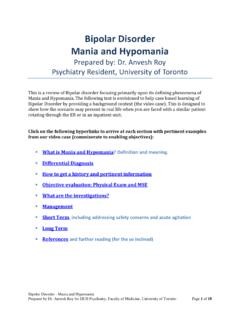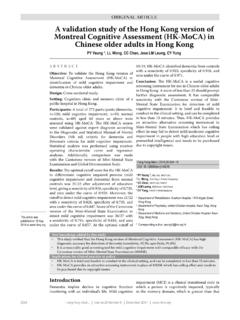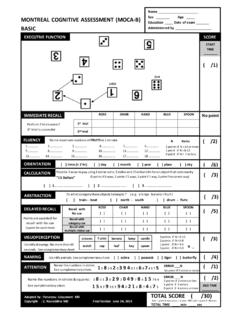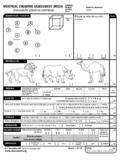Transcription of Montreal Cognitive Assessment (MoCA) Version 3 ...
1 moca Version3; May 2011 Adapted by Z. Nasreddine MD, N. Phillips, PhD, H. Chertkow, MD Z. Nasreddine MD 1 Montreal Cognitive Assessment ( moca ) Version 3 administration and Scoring Instructions The Montreal Cognitive Assessment ( moca ) was designed as a rapid screening instrument for mild Cognitive dysfunction. It assesses different Cognitive domains: attention and concentration, executive functions, memory, language, visuoconstructional skills, conceptual thinking, calculations, and orientation. Time to administer the moca is approximately 10 minutes. The total possible score is 30 points; a score of 26 or above is considered normal. 1. Alternating Trail Making: administration : The examiner instructs the subject: "Please draw a line, going from a number to a letter in ascending order.
2 Begin here [point to (1)] and draw a line from 1 then to A then to 2 and so on. End here [point to (E)]." Scoring: Allocate one point if the subject successfully draws the following pattern: 1 A0 20 B0 30 C0 40 D0 50 E, without drawing any lines that cross. Any error that is not immediately self0corrected earns a score of 0. 2. Visuoconstructional Skills (Cylinder): administration : The examiner gives the following instructions, pointing to the cylinder: Copy this drawing as accurately as you can, in the space below . Scoring: One point is allocated for a correctly executed drawing. Drawing must be three0dimensional All lines/ovals are drawn No line is added The horizontal lines are relatively parallel. The objects at the end must be ovals rather than circles.
3 The horizontal lines must touch the top/bottom of the ovals. A point is not assigned if any of the above0criteria are not met. 3. Visuoconstructional Skills (Clock): administration : Indicate the right third of the space and give the following instructions: Draw a clock. Put in all the numbers and set the time to ten past nine . Scoring: One point is allocated for each of the following three criteria: Contour (1 pt.): the clock face must be a circle with only minor distortion acceptable ( , slight imperfection on closing the circle); Numbers (1 pt.): all clock numbers must be present with no additional numbers; numbers must be in the correct order and placed in the approximate quadrants on the clock face; Roman numerals are acceptable; numbers can be placed outside the circle contour; Hands (1 pt.)
4 : there must be two hands jointly indicating the correct time; the hour hand must be clearly shorter than the minute hand; hands must be centred within the clock face with their junction close to the clock centre. moca Version3; May 2011 Adapted by Z. Nasreddine MD, N. Phillips, PhD, H. Chertkow, MD Z. Nasreddine MD 2 A point is not assigned for a given element if any of the above0criteria are not met. 4. Naming: administration : Beginning on the left, point to each figure and say: Tell me the name of this animal . Scoring: One point each is given for the following responses: (1) donkey (or mule); (2) pig (or hog); (3) kangaroo. 5. Memory: administration : The examiner reads a list of 5 words at a rate of one per second, giving the following instructions: This is a memory test.
5 I am going to read a list of words that you will have to remember now and later on. Listen carefully. When I am through, tell me as many words as you can remember. It doesn t matter in what order you say them. Mark a check in the allocated space for each word the subject produces on this first trial. When the subject indicates that (s)he has finished (has recalled all words), or can recall no more words, read the list a second time with the following instructions: I am going to read the same list for a second time. Try to remember and tell me as many words as you can, including words you said the first time. Put a check in the allocated space for each word the subject recalls after the second trial. At the end of the second trial, inform the subject that (s)he will be asked to recall these words again by saying, I will ask you to recall those words again at the end of the test.
6 Scoring: No points are given for Trials One and Two. Scoring is based on the delayed recall trial. 6. Attention: Forward Digit Span: administration : Give the following instruction: I am going to say some numbers and when I am through, repeat them to me exactly as I said them . Read the five number sequence at a rate of one digit per second. Backward Digit Span: administration : Give the following instruction: Now I am going to say some more numbers, but when I am through you must repeat them to me in the backwards order. Read the three number sequence at a rate of one digit per second. Scoring: Allocate one point for each sequence correctly repeated, ( : the correct response for the backwards trial is 40701). moca Version3; May 2011 Adapted by Z.
7 Nasreddine MD, N. Phillips, PhD, H. Chertkow, MD Z. Nasreddine MD 3 7. Vigilance: administration : The examiner reads the list of letters at a rate of one per second, after giving the following instruction: I am going to read a sequence of letters. Every time I say the letter A, tap your hand once. If I say a different letter, do not tap your hand . Scoring: Give one point if there is zero to one errors (an error is a tap on a wrong letter or a failure to tap on letter A). 8. Serial 7s: administration : The examiner gives the following instruction: Now, I will ask you to count by subtracting 7 from 80, and then, keep subtracting 7 from your answer until I tell you to stop. Give this instruction twice if necessary. Scoring: This item is scored out of 3 points.
8 Give no (0) points for no correct subtractions, 1 point for one correction subtraction, 2 points for two0to0three correct subtractions, and 3 points if the participant successfully makes four or five correct subtractions. Count each correct subtraction of 7 beginning at 80. Each subtraction is evaluated independently; that is, if the participant responds with an incorrect number but continues to correctly subtract 7 from it, give a point for each correct subtraction. For example, a participant may respond 72 65 58 51 44 where the 72 is incorrect, but all subsequent numbers are subtracted correctly. This is one error and the item would be given a score of 3. 9. Sentence repetition: administration : The examiner gives the following instructions: I am going to read you a sentence.
9 Repeat it after me, exactly as I say it [pause]: She heard his lawyer was the one to sue after the accident. Following the response, say: Now I am going to read you another sentence. Repeat it after me, exactly as I say it [pause]: The little girls who were given too much candy got stomach aches. Scoring: Allocate 1 point for each sentence correctly repeated. Repetition must be exact. Be alert for errors that are omissions ( , omitting "too much") and substitutions/additions ( , " .. his lawyer sued after .. ; the girls ), altering plurals, etc.). 10. Verbal fluency: administration : The examiner gives the following instruction: Tell me as many words as you can think of that begin with a certain letter of the alphabet that I will tell you in a moment.
10 You can say any kind of word you want, except for proper nouns (like Peter or Paris), numbers, or words that begin with the same sound but have a different suffix, for example, love, lover, loving. I will tell you to stop after one minute. Are you ready? [Pause] Now, tell me as many words as you can think of that begin with the letter B. [time for 60 sec]. Stop. Scoring: Allocate one point if the subject generates 11 words or more in 60 sec. Record the subject s response in the bottom or side margins. moca Version3; May 2011 Adapted by Z. Nasreddine MD, N. Phillips, PhD, H. Chertkow, MD Z. Nasreddine MD 4 11. Abstraction: administration : The examiner asks the subject to explain what each pair of words has in common, starting with the example: Tell me how an orange and a banana are alike.













